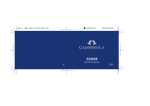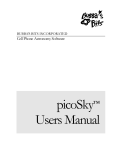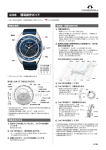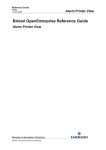Download Accurist CELESTIAL Instruction manual
Transcript
CELESTIAL WATCH INSTRUCTION MANUAL Contents 1. Specifications ..................................................................................3 2. Celestial Watch ................................................................................4 3. Constellation Display of Entire Sky at 50° (or 35°) North Latitude...5 4. Features ...........................................................................................6 5. Setting the Time and Constellation Dial ........................................8 6. Times for Sunrise and Sunset ......................................................10 7. Concerning Constellation Dial Display .........................................11 8. Abbreviations of Constellations and their full spellings ................12 9. Nebulae and Star Clusters on the Constellation dial.......................16 10. Diagram of the Constellation Dial ...............................................18 11. Precautionary Items and Usage Limitations ................................20 12. Warranty and Service ...................................................................29 1. Specifications 1. Calibre No: 4P92 2. Frequency of crystal oscillator: 32.768 Hz (Hz: frequency per second). 3. Accuracy: Within +/- 20 seconds per month (when worn at normal temperature +5°C - + 35°C) 4. Operating temperature range: -10°C - +60°C 5. Additional Functions: • Constellation display functions (period of constellation dial rotation: approx 23 hours 56 minutes and 4 seconds) • Planisphere dial function • Displaying of solar position • Displaying of altitude and azimuth • Displaying of local sidereal time • Twilight identification function • Displaying of pole star angle 6. Battery: Silver oxide battery 1 pce. 280-39(SR626SW) 7. Battery life: Approximately 3 years (after installing a new battery). Specifications are subject to change without notice. 3. 2. Celestial Watch The Celestial Watch is a precisely designed analog quartz watch that displays not only the current time but also the correct positions of the constellations as they move across the sky. The Celestial Watch shows azimuth (bearing) and altitude (angular position above the horizon) of the major fixed stars, nebulae, galaxies and star clusters, displays local sidereal (star) time, stellar spectral type. The Celestial Watch also has features that provide such convenient information as the position of the sun, the time of sunrise and sunset, and thus the hours of darkness when astronomical observations may be made. 4. 3. Constellation Display of Entire Sky at 50° or 35°North Right ascension scale Date scale Direction for turning constellation dial Zenith Ecliptic Celestial equator -18 altitude (twilight zone) Constellation dial setting Crown Time setting Normal position Meridian Horizon 5. Because distortion is minimal in the northern hemisphere, approximately 98.5% of the celestial sphere visible at 50° or 35° north latitude is displayed. (The range shown on the constellation dials from -40° to +90° declination). The design varies from one model to another. 4. Features The Constellation display includes the positions of 1056 fixed stars with a brightness of the 4.8th magnitude or brighter, 169 major nebulae,galaxies and star clusters, constellation boundaries and the ecliptic and the celestial equator based on their positions for the year 2000.0. (Maximum magnitude values are indicated for variable stars. Fixed stars are represented by a four colour spectrum at 0.1 magnitude intervals). The constellation dial not only automatically displays the present positions of constellations but can also be used as a planisphere dial in which the constellations dial is independently rotated. The solar position display shows the position of the sun along the ecliptic (the sun’s apparent path on the celestial sphere during the year) on the 1st, 11th and 21st of each month (for 12 noon universal time over the mean year). Times for sunrise and sunset as well as the number of daylight hours are determined by looking on the horizon line on the transparent dial. The altazimuth display lets you determine the altitude and azimuth of the sun as well as the major fixed stars, nebulae, galaxies and star clusters on the celestial sphere. (The equidistant almucanter lines at intervals of 15° on the transparent dial are corrected for atmospheric aberration. 6. 4. Features continued... The local sidereal time display lets you easily determine the location of the constellations. (Local sidereal time can be read off the right ascension graduation on the constellation dial opposite the correct date on the date scale). The twilight indicator lets you identify the hours of increasing darkness, especially convenient for astronomical observations. (Astronomical twilight line: use the -18° altitude on the transparent dial to determine the beginning and ending times for the hours of astronomical twilight). The pole star hour angle display lets you align an astronomical telescope to the polar axis. (Right ascension values for the pole star between the years 2000.0 - 2050.0 are marked on the constellation dial for every ten years). Hour angle is the angle measured counterclockwise from the meridian on the transparent dial to the point marking the value for the right ascension the present pole star. The celestial sphere at the centre of the rotating constellation dial is not displayed owing to the attachment of the watch hands. 7. 5. Setting the Time and Constellation Dial Setting the time 1) When the second hand indicates 0 seconds, pull the crown out to the second position. 2) Turn the crown and set the hour and minute hands to the correct time. Move the minute hand 4 to 5 minutes ahead of the correct position and then return it to the correct position. 3) Properly push the crown into its normal position in accordance with a standard time signal or the like. Setting the constellation dial 1) First it is necessary to find the correct sidereal time for the local standard meridian or the universal time meridian. 2) Check the time difference in sidereal time between observation point longitude and the standard meridian for the sidereal time source. Local sidereal time depends on longitude, and is advanced four minutes per degree eastward. 3) Pull the crown out to the first position. 4) Calculate the time obtained by adding the present sidereal time (displayed on the 24 hour time scale) to the sum of the difference between local sidereal time and present time. Find the value corresponding to this time on the right ascension scale, and align it with the date scale turning the constellation 8. dial clockwise. 5. Setting the Time and Constellation Dial continued... June 11 11.40 Example: To align the constellation dial for 12.00 June 11 at a position 5° west of the standard time longitude, turn the constellation dial clockwise until the point on the dials right ascension scale opposite 11.40 is in line with the point on the date scale corresponding to June 11. 7) Push the crown into its normal position. Increments on the date scale are calibrated for 12 noon Universal Time (21h Japanese Standard Time) over the mean year. Wide lines of the date scale are indicated for the 1st. 11th and 21st of each month. Narrow lines of the date scale are indicated for the 6th, 16th and 26th of each month. 9. 6. Times for Sunrise and Sunset Example: Sunrise time for March 11 at the standard time longitude. 1) Pull the crown out to the first position. March 11 2) Turn the crown and bring the solar position 6:23 for March 11 on the March 11 ecliptic on the constellation dial so that it overlaps the transparent dials outline of the east horizon. 3) The mean solar time of sunrise will be shown as the constellation dials right ascension scale corresponding to the date for March 11. In areas where summertime is in force add one hour to the time indicated. After checking this function, turn the crown and return the constellation dial clockwise to its present position. Push the crown into its normal position. 10. 7. Concerning the Constellation Dial Display The fixed stars are generally classified into the following four spectral types according to their spectra. Bluish silver ........Spectrum O or B type stars 274 stars Silver ...................Spectrum A or F type stars 354 stars Yellowish silver....Spectrum G or K type stars 353 stars Orangish silver.....Spectrum G or K type stars 75 stars Stellar magnitudes are displayed near the right ascension graduations of Oh on the constellation dial. Hard to differentiate neighbouring stars (including multiple stars) are indicated in terms of synthetic brightness, with the colour being that of the spectral class for the main (brightest in appearance) star in the binary stars. Variable stars are not distinguished from other fixed stars. The major nebulae, galaxies and star clusters are displayed in light green on the constellation dial. The star clusters of Pleiades and Hyades are shown together. 11. 8. Abbreviations of Constellations and their full spellings Abbreviations Full Spellings Abbreviations Full Spellings And Ant Aps Aql Aqr Ara Ari Aur Boo Cae Cam Cap Andromeda Antlia Apus Aquila Aquarius Ara Aries Auriga Bootes Caelum Camelopardalis Caprico Car Cas Cen Cep Cet Cha Cir CMa CMi Cnc Col Com Carina Cassiopeia Centaurus Cepheus Cetus Chamaeleon Circinus Canis Major Canis Minor Cancer Columba Coma Berenices 12. 8. Abbreviations of Constellations and their full spellings continued... 13. Abbreviations Full Spellings Abbreviations Full Spellings CrA CrB Crt Cru Crv CVn Cyg Del Dor Dra Equ Eri Coruna Australis Coruna Borealis Crater Crux Corvus Canes Venatici Cygnus Delphinus Dorado Draco Equuleus Eridanus For Gem Gru Her Hor Hya Hyi Ind Lac Leo Lep Lib Fornax Gemini Grus Hercules Horologium Hydra Hydrus Indus Lacerta Leo Lepus Libra 8. Abbreviations of Constellations and their full spellings continued... Abbreviations Full Spellings Abbreviations Full Spellings LMi Lup Lyn Lyr Men Mic Mon Mus Nor Oct Oph Ori Leo Minor Lupus Lynx Lyra Mensa Microscopium Monoceros Musca Norma Octans Ophiuchus Orion Pav Peg Per Phe Pic PsA Psc Pup Pyx Ret Scl Sco Pavo Pegasus Perseus Phoenix Pictor Piscis Austrinus Pisces Puppis Pyxis Reticulum Sculptor Scorpius 8. Abbreviations of Constellations and their full spellings continued... Abbreviations Full Spellings Abbreviations Full Spellings Sct Ser Ser Ser Sex Sge Sgr Tau Tel Scutum Serpens Serpens Caput Serpens Cauda Sextans Sagitta Sagittarius Taurus Telescopium TrA Tri Tuc UMa UMi Vel Vir Vol Vul Triangulum Australe Triangulum Tucana Ursa Major Ursa Mino Vela Virgo Volans Vulpecularnus Abbreviations are not shown for the constellations Aps, Cha, Cir, Cru, Hyi, Men, Mus, Oct, Pav, TrA, Tue and Vol since they are included in the entire or nearly entire range of the celestial sphere unable to be viewed from 35° north latitude. 15. 9. Nebulae, Galaxies and Star Clusters on the Constellation Dial in Light Green M31(And) NGC752(And) M72(Aqr) NGC7009(Aqr) NGC7293(Aqr) NGC6167(Ara) 1.4651(Ara) NGC6397(Ara) M38(Aur) M36(Aur) M37 (Aur) NGC2403(Cam) M30(Cap) NGC281(Cas) NGC457(Cas) NGC559(Cas) M103(Cas) 1.1805(Cas) 1.1848(Cas) NGC7635(Cas) M52(Cas) NGC7789(Cas) NGC4945(Cen) NGC5128(Cen) NGC5139(Cen) NGC5460(Cen) NGC6946(Cep) NGC247(Cet) NGC246(Cet) M77(Cet) M41(CMa) M44(Cnc) M67(Cnc) NGC1851(Col) M98(Com) M99(Com) M100(Com) M85(Com) M88(Com) NGC4548(Com) NGC4565(Com) M64(Com) M53(Com) NGC6541(CrA) NGC4258(CVn) NGC4449(CVn) NGC4631(CVn) M94(CVn) M63(CVn) M51(CVn) M3(CVn) NGC6871(Cyg) 1.1318(Cyg) M29(Cyg) NGC6992-5(Cyg) NGC7000(Cyg) M39(Cyg) NGC5866(Dra) NGC1291(Eri) NGC1316(For) M35(Gem) NGC2392(Gem) M13(Her) M92(Her) M48(Hya) NGC3242(Hya) M68(Hya) M83(Hya) NGC2903(Leo) M95(Leo) M96(Leo) NGC3379(Leo) NGC3521(Leo) M65(Leo) M66(Leo) M79(Lep) NGC5897(Lib) NGC5822(Lup) NGC5986(Lup) M57(Lyr) M56(Lyr) NGC2237-9(Mon) NGC2301(Mon) M50(Mon) NGC6067(Nor) NGC6171(Oph) M12(Oph) M10(Oph) M62(Oph) M19(Oph) M9(Oph) M14(Oph) NGC6633(Oph) 16. 9. Nebulae, Galaxies and Star Clusters on the Constellation Dial in Light Green continued ... M42(Ori) M78(Ori) NGC2174-5(Ori) M15(Peg) M76(Per) NGC869(Per) NGC884(Per) M34(Per) NGC1245(Per) NGC1499(Per) NGC1528(Per) M74(Psc) M47(Pup) M46(Pup) M93(Pup) NGC2546(Pup) NGC55(Scl) NGC253(Scl) NGC300(Scl) M80(Sco) M4(Sco) NGC6124(Sco) H12(Sco) M6(Sco) M7(Sco) M26(Sct) M11(Sct) M5(Ser) M16(Ser) 1.4756(Ser) M71(Sge) M23(Sgr) M20(Sgr) M8(Sgr) M21(Sgr) M24(Sgr) M18(Sgr) M17(Sgr) M28(Sgr) M69(Sgr) M25(Sgr) M22(Sgr) M70(Sgr) M54(Sgr) NGC1746(Tau) M1(Tau) M33(Tri) M81(UMa) M82(UMa) NGC3556(Uma)M97(Uma) M101(UMa) NGC2547(Vel) 1.2395(Vel) H3(Vel) NGC3132(Vel) NGC3201(Vel) M61(Vir) M84(Vir) M49(Vir) M87(Vir)M89(Vir) M90(Vir) M58(Vir) M104(Vir) M59(Vir) M60(Vir) M27(Vul)NGC6940(Vul) Nebulae and star clusters are arranged in alphabetical order of the constellations to which they belong and in the order of right ascention within a particular constellation (moving to the right around the constellation dial). 17. 10. Diagram of the Constellation Dial 1) Sirius (Cma) 2) Canupus (Car) 3) Arcturus (Boo) 4) Vega (Lyr) 5) Capella (Aur) 6) Rigel (Ori) 7) Procyon (CMi) 8) Betelgeuse (Ori) 18. 10. Diagram of the Constellation Dial continued... 9) Altair (Aql) 10) Aldebaran (Tau) 11) Antares (Sco) 12) Spica (Vir) 19. 13) Stellar magnitudes 14) Milky Way 15) Solar Position (Oct 21) 16) Right ascension of the pole star (2000.0) 11. Precautionary Items and Usage Limitations Water Resistance ! WARNING Water Resistance Water-resistance for daily use (to 3 atmospheres) means that the watch may be worn while washing your face or in the rain but it is not to be immersed in water. Indication Case (Case back) Name Dial Everyday-use water resistant watch No indication Specification WATER RESIST Water-resistant to 3 bar 3 atmospheres 20. 11. Precautionary Items and Usage Limitations continued... Water Resistance Refer to the watch dial and the case back for the indication of the water resistance of your watch. The following list provides examples of use for reference to ensure that your watch is used properly. (The unit “bar” is roughly equal to 1 atmosphere). When water is simply splashed onto the watch (washing your face or in rain. Swimming and general washing work (kitchen work / swimming etc..). Water sports and skin diving (without and air tank). Scuba Diving (with air tank). Operate the crown when watch is wet. 21. 11. Precautionary Items and Usage Limitations continued... Before using this watch, read this instruction manual carefully to ensure correct use. After reading this manual store it in a safe place for future reference. Safety precautions (Instructions to be followed at all times) This manual contains the following instructions that should be strictly followed at all times to prevent injury to yourself and other persons as well as damage to property. Injuries and damage that might be caused by using the watch improperly or neglecting any of the instructions or precautions contained in this manual are classified with the following symbols. ! WARNING Can cause serious injury or death Important instructions that should be followed are classified with the following symbol. ! Warning (caution) symbol followed by instructions that should be followed or precautions that should be observed. 22. ! CAUTION When wearing your watch Be particularly careful when wearing your watch while holding a small child to avoid injury. Be particularly careful when engaged in strenuos exercise or work to avoid injury to yourself or others. Do NOT wear your watch in a sauna or other location where you may become excessively hot since there is a risk of burns. The rubber (urethane) band may be stained by dyes or soil present in or on clothing or other accessories. Since these stains may not be able to be removed, caution is required when wearing your watch with articles that tend to transfer colour (articles of clothing, purses, etc...) ! CAUTION Handling the band (Putting on and taking off) Be careful when putting on and taking off your watch since there is a risk of damaging your fingernails depending on the manner in which the band is being fastened. 23. ! CAUTION Always keep your watch clean Small amounts of dirt may become trapped in the tiny gap between the crown and case making it difficult to pull out the crown. It is recommended to occasionally turn the crown in its normal position to remove any dirt. The case and band of the watch come into direct contact with the skin in the same manner as undergarments. Corrosion of the metal or unnoticed soiling such as that caused by perspiration and dirt can soil sleeves and other portions of clothing. Wearing this watch may cause itching or rash if you have sensitive skin or certain physical conditions. If you think there is something wrong discontinue wearing the watch immediately and consult your physician. Possible causes of rashes include: 1. Allergy to certain metals or leather. 2. Rust, dirt or perspiration present on the watch’s body or band. Leather bands may become discoloured by perspiration or dirt. Always keep your leather band clean by wiping with a dry cloth. Do NOT wear the band too tightly. Try to leave enough space between the band and your skin to allow adequate ventilation. 24. Caring for your watch Wipe any dirt or moisture such as perspiration from the case and crystal with a soft cloth. Remove any dirt from a leather band with a dry cloth. For a metallic, plastic or rubber watchband wipe with a damp cloth. Remove the small amounts of dirt trapped between the crevices of the metallic band with a soft brush. Do NOT use solvents (such as paint thinner or benzene) for cleaning since they may mar the surface of the band. ! Warning Handling of the battery Keep the battery out of reach of small children. In the event a battery is swallowed consult a physician. ! Warning Battery Replacement If a depleted battery is left in your watch damage may be caused by the leakage of battery fluid. Be sure to replace the battery promptly. Always be sure to select a battery of the correct specifications when replacing the battery. 25. Temperature The function of the watch may be impaired or the watch may even stop if the ambient temperature is outside the range of -10°C to +60°C. If the watch is left for an extended period under temperatures outside the normal range (+5°C to +35°C) fluid may leak from the battery resulting in considerable shortening of battery life. Magnetism Do NOT allow the watch to come into close proximity with magnets. If the watch is used near a magnetic health device (magnetic necklace, magnetic elastic band etc...) or the magnets used in the latches of refrigerator doors, earphone of a mobile phone and so forth it will not keep time accurately. If this should happen move the watch away from the magnet and reset it to the correct time. Static Electricity The integrated circuits used in the watch are sensitive to static electricity. If exposed to static electricity the watch’s display may become incorrect. Strong Shock Avoid dropping the watch or subjecting it to other strong impact. 26. Chemicals, Corrosive Gasses and Mercury If paint thinner, benzene or other solvents or products containing these solvents (including gasoline, nail polish remover, bathroom cleaner and adhesives) are allowed to come into contact with the watch they may discolour, dissolve or crack the materials. Be careful when handling these chemicals. Contact with mercury such as that used in thermometers may also ause discolouration of the band and case. Storage If you will not be using your watch for an extended period of time, carefully wipe off any excess perspiration, dirt or moisture and store in a proper location avoiding locations subject to excessively high or low temperatures and high humidity. Do NOT leave a depleted battery in the watch for a long time. Be sure to replace with a new one. If battery fluid leaks out, it is likely to damage the watch. 27. 12. Warranty and Service 1. Guarantee In the case a malfunction has occurred during the course of normal use while the watch is still under warranty, the watch will be repaired free of charge in accordance with the conditions of warranty included with this manual. 2. Repair Availability Period You can have your watch repaired at normal repair rates during the repair part availability period of the manufacturer even if the warranty period has expired provided the watch has been used under normal conditions. Since this period varies considerably according to conditions of use and usage environment, please consult your dealer as to whether or not the repairs can be made by taking your watch directly to the dealer. Furthermore there may be cases when it may be difficult to restore the accuracy of the watch when it has deteriorated as a result of long term use. 28. 3. Periodic Inspection (Charge basis) You should have your watch inspected (Charge basis) every 2 - 3 years to extend its life and ensure safety. When replacing parts always make sure to request genuine parts. When it becomes necessary to replace packings and springs it may sometimes also be necessary to inspect other parts or to make repairs in addition to replacing the parts. Please ask for more detailed information on repair or replacement expenses at the shop where you purchased your watch. 4. Batteries The battery which was installed in your watch at the factory is a monitor use battery which monitors the functions and special features of your watch. You should keep in mind that the life of your battery could be shorter than the specified period. Even in the event that the battery runs out before the time specified in the guarantee there will be a fee for replacing the battery. 5. Other Inquiries If you have any questions regarding the warranty. repairs of other matters please inquire at the shop where you purchased your watch. 29. 30. 31. 32. Accurist Watches Ltd, Asher House, Blackburn Road, West Hampstead, London, NW6 1AW Switchboard: +44 (0)207 447 3900 Fax: +44 (0)207 447 3925 Email: [email protected] Web: www.accurist.co.uk









































